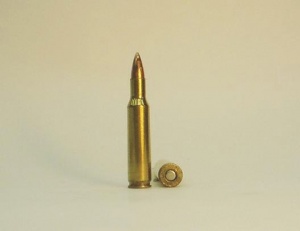.222 Remington
| .222 Remington | |||||||||||||||||||
|---|---|---|---|---|---|---|---|---|---|---|---|---|---|---|---|---|---|---|---|

| |||||||||||||||||||
| Type | Rifle | ||||||||||||||||||
| Country of Origin | USA | ||||||||||||||||||
| Specifications | |||||||||||||||||||
| Case Type | Rimless, bottleneck | ||||||||||||||||||
| Bullet Ø | .224 in (5.7 mm) | ||||||||||||||||||
| Neck Ø | .253 in (6.4 mm) | ||||||||||||||||||
| Shoulder Ø | .357 in (9.1 mm) | ||||||||||||||||||
| Base Ø | .376 in (9.6 mm) | ||||||||||||||||||
| Rim Ø | .378 in (9.6 mm) | ||||||||||||||||||
| Case Length | 1.700 in (43.2 mm) | ||||||||||||||||||
| Full Length | 2.130 in (54.1 mm) | ||||||||||||||||||
| Rifling twist | 1-12" | ||||||||||||||||||
| Primer | Small rifle | ||||||||||||||||||
| Production & Service | |||||||||||||||||||
| Designer | Mike Walker | ||||||||||||||||||
| Design Date | 1950 | ||||||||||||||||||
| Manufacturer | Remington | ||||||||||||||||||
| Ballistic Performance Sampling | |||||||||||||||||||
| |||||||||||||||||||
Contents[hide] |
Introduction
The .222 Remington was introduced in the Remington Arms Model 722 bolt action rifle, and was an instant success. It was not unusual for factory rifles to produce groups of one minute of arc (0.3 mrad) with no tuning. The accuracy and flat trajectory of the cartridge meant that it was quickly adopted for varmint and benchrest rifles, and was the dominant cartridge in both disciplines for decades. While the faster .220 Swift and .22-250 provide more reach, it's at the expense of far more powder (roughly 50% more), muzzle blast, and barrel erosion. For example, maximum loads for a .222 Remington average 25 grains (1.6 g), the .22-250 averages 41 grains (2.7 g), and the .220 Swift averages 46 grains (3.0 g) for its maximum. [1]
The .222 Remington was also popular in Europe. Sako was one of the first European makers to introduce .222 Remington rifles and cartridges, and German and Austrian hunters quickly adopted the .222 Remington for hunting smaller deer sized game.
Obsolescence
The .222 Rem. was finally eclipsed in benchrest competition by the 6 mm PPC cartridge, a dedicated benchrest cartridge, chambered almost exclusively in single shot rifles. The 6 mm PPC is still a top benchrest cartridge.
When the US military was looking for a new smallbore rifle cartridge, Remington started with the .222 Remington, and stretched it to increase powder capacity by about 20% in 1958 to make the .222 Remington Magnum. The greater powder capacity put the velocities between the standard .222 Remington and the 22-250. The cartridge was not accepted by the military, but it was introduced commercially. In 1964, the 5.56 x 45 mm, also based on a stretched .222 Rem. case, was adopted along with the new M-16 rifle. The 5.56 mm cartridge had a capacity only slightly less than the .222 Rem. Mag., about 5% less, so when Remington introduced the commercial variant of the new military cartridge, the .223 Remington, both the .222 Remington and the .222 Rem. Mag. faded quickly into obsolescence, being replaced by the .223 Remington.
While the .222 Remington is rarely found in current production, its derivative cartridges are among the most popular in the world. In addition to the .222 Rem. Mag. and .223 Remington, the .222 has also served as the parent case for the .221 Fireball, the fastest production handgun cartridge, and the new .204 Ruger, the fastest production rifle cartridge.Still, the .222 Remington has its small marketplace as firearms that are factory chambered for the .223 Remington/5.56x45mm NATO caliber are often rechambered for the .222 Rem. for the distribution in Countries whose regulations restrict or forbid civilian ownership of "military calibers"; examples of countries with such legislations are France and Spain.
See also
References
- Speer Reloading Manual #11, Omark Industries, Inc. 1987
- Cartridge Dimensions
- Cartridge dimensions and load data at Accurate Powder
External links
- .222 Remington and .222 Rem Mag. by Chuck Hawks
